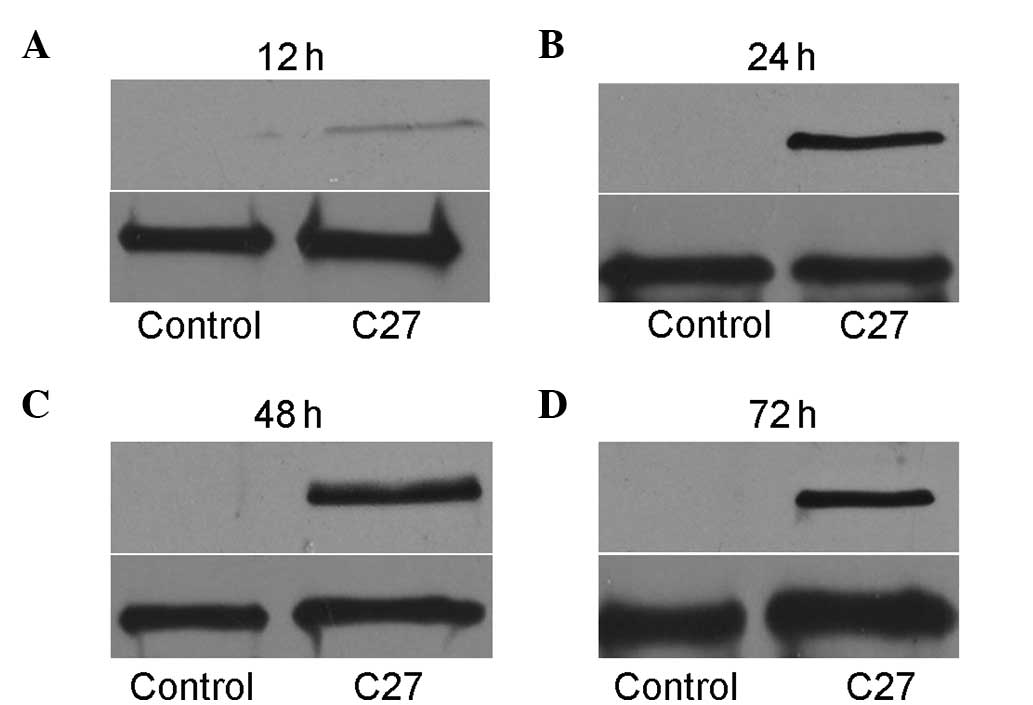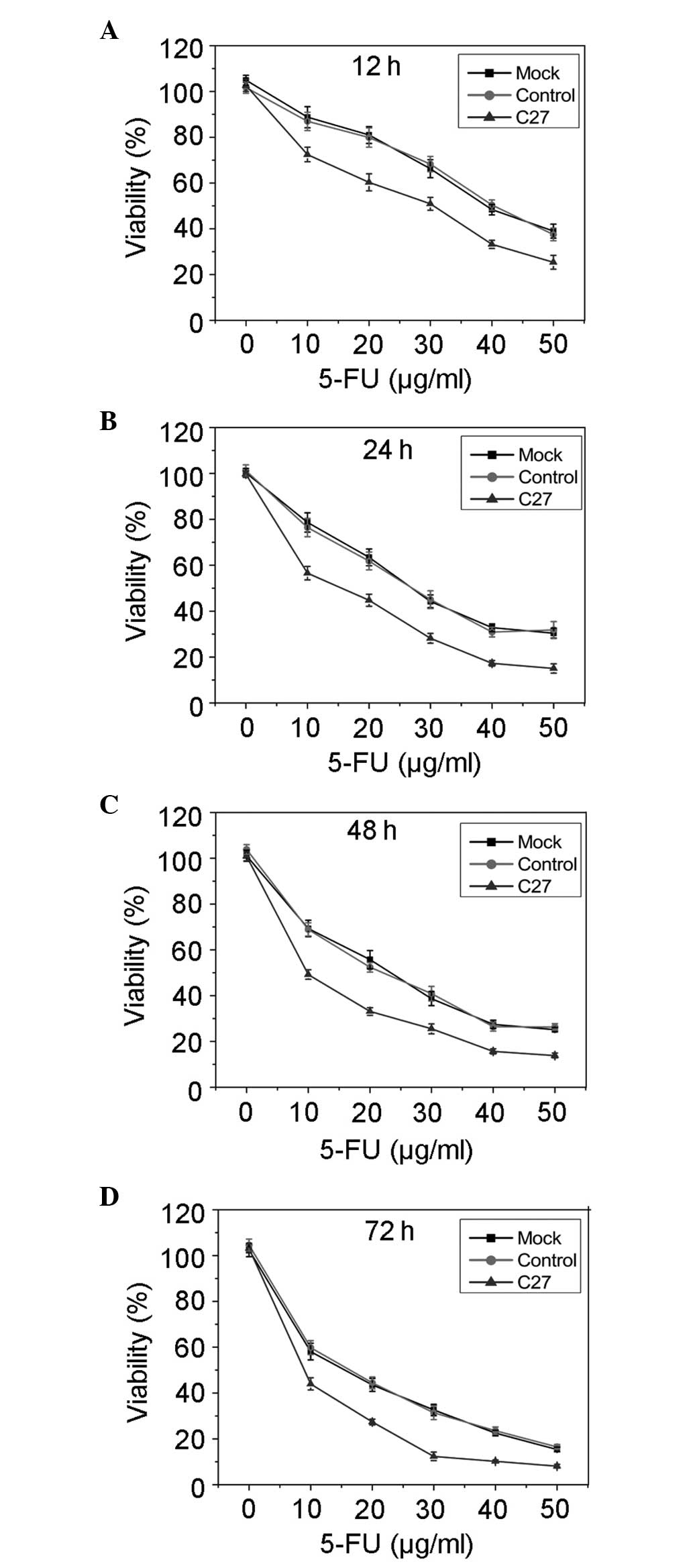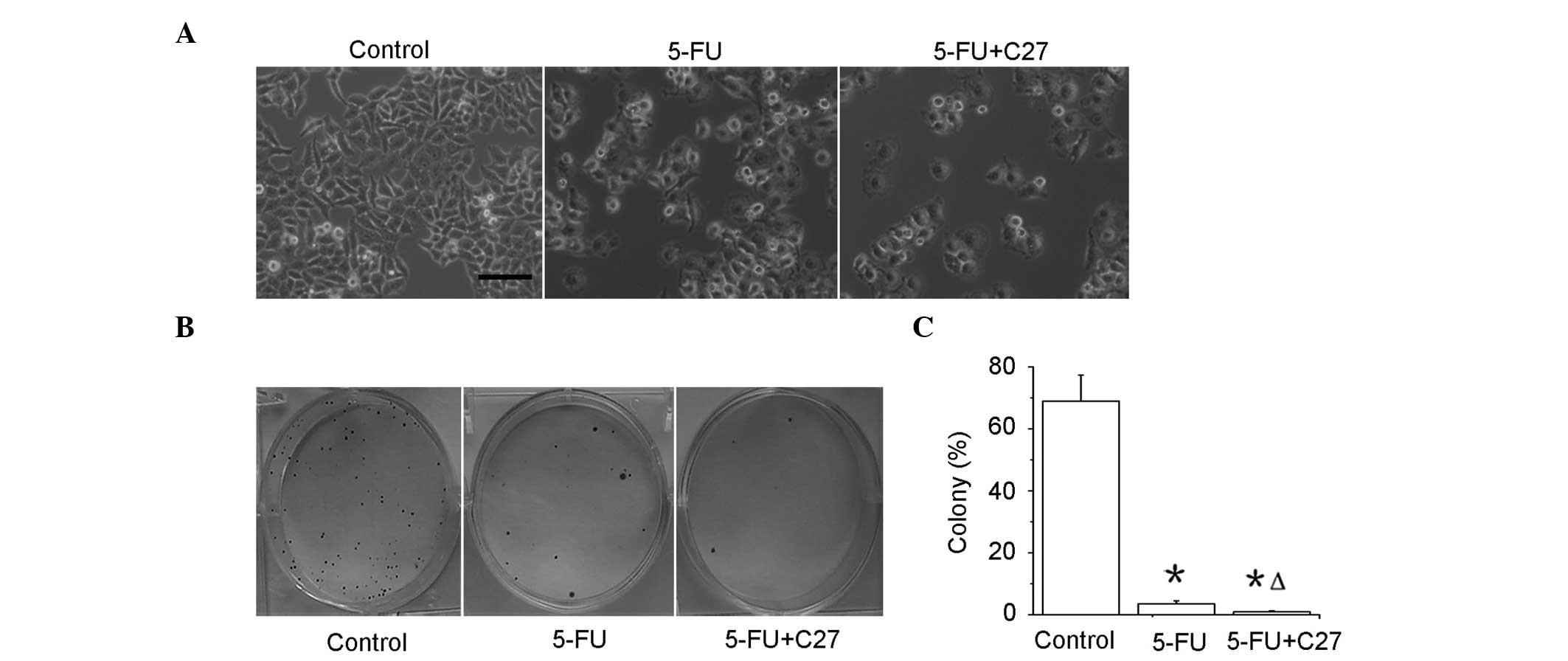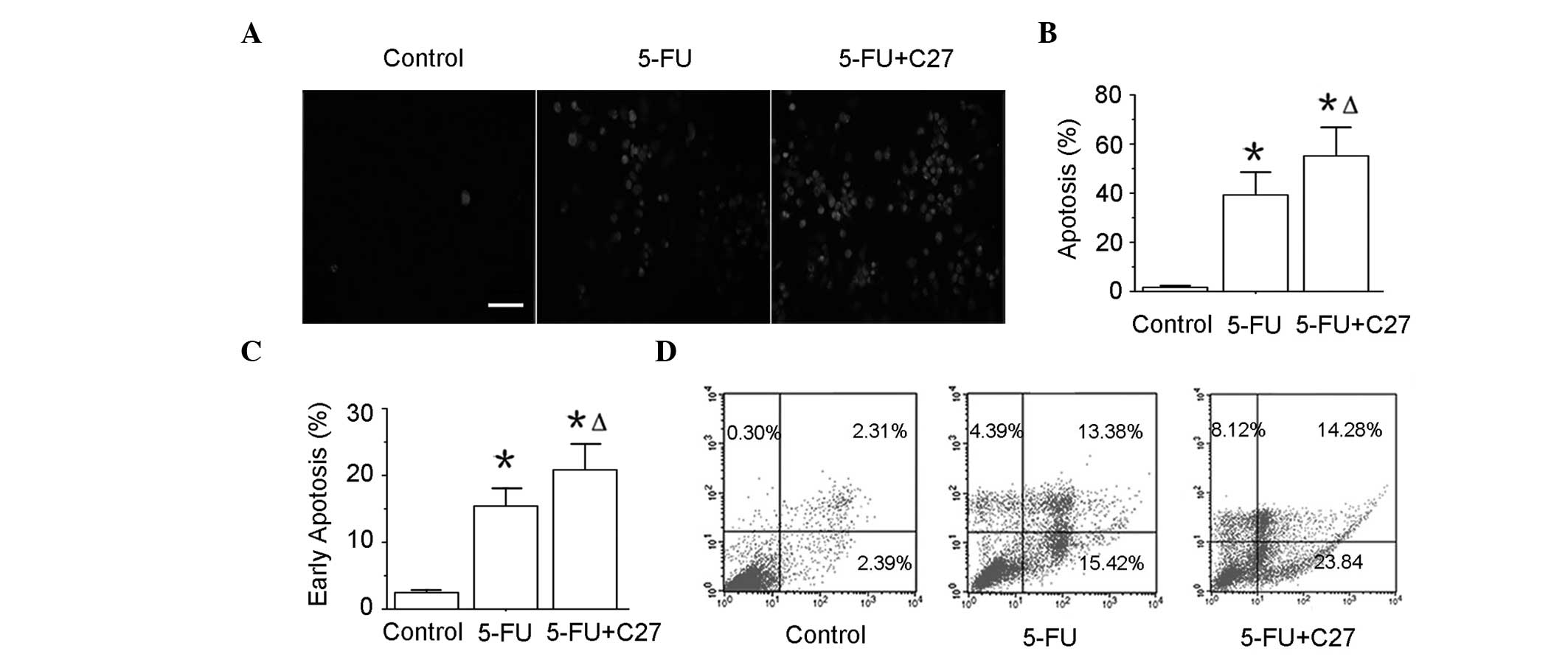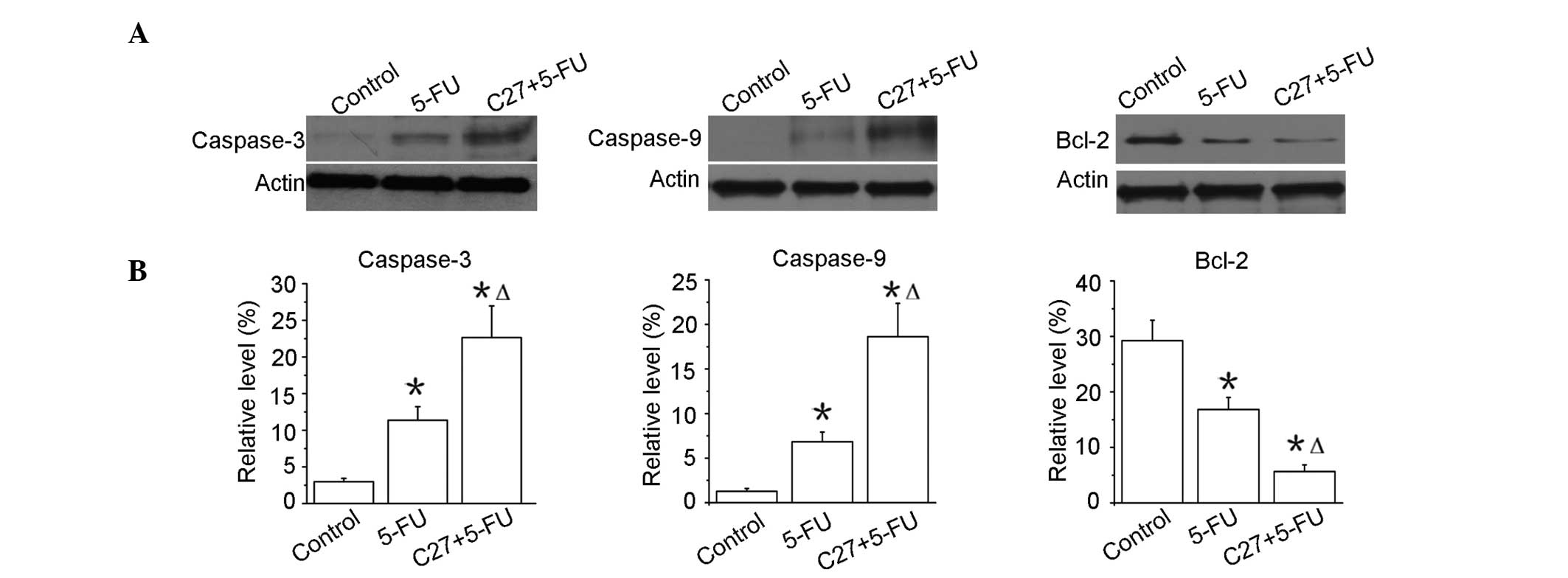Overexpression of human telomerase reverse transcriptase C-terminal polypeptide sensitizes HeLa cells to 5-fluorouracil‑induced growth inhibition and apoptosis
- Authors:
- Published online on: November 5, 2013 https://doi.org/10.3892/mmr.2013.1777
- Pages: 279-284
Abstract
Introduction
Cervical carcinoma is one of the most frequent types of cancer encountered in women (1). Currently, 5-fluorouracil (5-FU), a commonly used antitumor chemotherapeutic drug, has been shown to be one of the standard chemoradiotherapy regimens in the treatment of many carcinomas including cervical cancer (2–4). However, tumor recurrence and metastasis occur in a large number of cancer patients mainly due to limited drug sensitivity and an increased drug resistance (5). Therefore, novel strategies of gene therapy for enhancing the sensitivity of cancer cells to drug-induced growth inhibition and apoptosis have been intensively explored (6–8).
Telomerase is an attractive molecular target for cancer gene therapy due to its high prevalence in tumor cells (9–11). Human telomerase is a ribonucleoprotein complex, which is composed of an RNA component hTR and telomerase reverse transcriptase (TERT), the catalytic protein subunit of telomerase (12). The enzyme TERT is critical for maintaining the telomere length and prolonging the life span of cells, thereby contributing to uncontrolled cell proliferation (10). Telomerase activity is markedly increased in the majority of tumors but not detected in the majority of normal cells. The reactivation of telomerase during carcinogenesis is a common hallmark in the majority of human tumors. In our previous study, hTERTC27, a 27 kDa C-terminal polypeptide of hTERT, was reported to clearly decrease cell proliferation and inhibit the tumorigenicity of human cervical carcinoma and glioblastoma by promoting chromosome end-to-end fusion during anaphase and by inducing telomere dysfunction (13–16). However, hTERTC27 treatment alone may not be capable of achieving a long-term benefit for cancer therapy due to the unstable expression of this polypeptide, and the problem of therapeutic gene integrating into the genome of tumor cells with a rapidly dividing nature. However, it is noteworthy that ectopic overexpression of this polypeptide markedly enhances the sensitivity of HeLa cells to H2O2 treatment. Therefore, we hypothesized that hTERTC27 overexpression is a potentially effective strategy for sensitizing cervical tumor cells to chemotherapeutics and enhancing the antitumor effect of 5-FU chemotherapy.
To the best of our knowledge, the present is the first study to report the antitumor effects of 5-FU and overexpressed hTERTC27 on cervical carcinoma HeLa cells. Overexpressed hTERTC27 increased the sensitivity of the HeLa cells to 5-FU and significantly inhibited the HeLa cell proliferation with 5-FU treatment. In addition, hTERTC27 overexpression clearly promoted 5-FU-induced apoptosis by upregulating the expression of activated caspase-3 and -9, and downregulating the expression of B-cell lymphoma 2 (Bcl-2). These results indicate that overexpression of hTERTC27 may provide a novel approach for enhancing the sensitivity of 5-FU chemotherapy in the treatment of cervical carcinoma.
Materials and methods
Cell culture
Human cervical cancer HeLa cells were obtained from ATCC (Manassas, VA, USA) and maintained in Dulbecco’s modified Eagle’s medium (DMEM; Hyclone Laboratories, Inc., South Logan, UT, USA), supplemented with 10% fetal bovine serum (FBS; Hyclone Laboratories, Inc.), 100 μg/ml penicillin (Ameresco, Middletown, CT, USA) and 100 μg/ml streptomycin (Ameresco). The cells were cultured at 37°C in a humidified atmosphere with 5% CO2.
Transfection
The pcDNA3.1-hTERTC27 plasmid was maintained in our laboratory. cDNAs of a 27 kDa hTERT C-terminal polypeptide (hTERTC27, amino acid residues 882–1132) was constructed downstream. The HeLa cells were transfected with pcDNA3.1 vectors (known as control-HeLa cells) or pcDNA3.1-hTERTC27 vectors (termed C27-HeLa cells) using Lipofectamine 2000 transfection reagent (Invitrogen Life Technologies, Carlsbad, CA, USA) and following the manufacturer’s instructions. The untransfected HeLa cells were designated as mock-HeLa cells. Twenty-four hours after transfection, the cells were treated with 5-FU and experiments were subsequently performed.
Western blot analysis
The expression of hTERTC27 was detected at 12, 24, 48 and 72 h after transfection. The expression of caspase-3, -9 and Bcl-2 was detected 48 h after 5-FU treatment. Western blot analysis was performed as described previously (17). Antibodies against the hTERT COOH-terminal fragment (1:250; Santa Cruz Biotechnology, Inc., Santa Cruz, CA, USA), cleaved caspase-3 (1:1,000) and cleaved caspase-9 (1:1,000; both Cell Signaling Technology, Inc., Danvers, MA, USA) and Bcl-2 (1:500; Santa Cruz Biotechnology, Inc.) were used. The bound antibodies were located by further incubation with horseradish peroxidase-conjugated goat anti-rabblit IgG (1:5,000; Santa Cruz Biotechnology, Inc.). β-actin (1:500; Santa Cruz Biotechnology, Inc.) was used as a loading control. Blots were developed with an ECL plus kit (Pierce Biotechnology, Inc., Rockford, IL, USA), and exposed to Kodak film (Eastman Kodak Company, Rochester, NY, USA). The National Institutes of Health Image program was used to quantify the intensity of the resulting bands.
MTT assay
In total, 2×103 HeLa cells (mock, control and C27) were seeded in a 96-well plate 24 h after transfection. After 12 h, the cells were treated with different concentrations (in μg/ml) of 5-FU of 0, 10, 20, 30, 40 or 50, respectively. The MTT assay was then performed at 12, 24, 48 and 72 h after 5-FU treatment. Briefly, 20 μl of 5 mg/ml MTT (Sigma, St. Louis, MO, USA) in PBS was added and the cells were incubated for 4 h at 37°C with 5% CO2. The cells were washed twice with PBS and the pellet was then solubilized in 150 μl of 100% dimethylsulfoxide (Sigma) by agitating for 5 mins. The absorbance was measured on a microplate reader (Bio-Rad, Hercules, CA, USA) at a wavelength of 570 nm. The rate of cell viability was calculated according to the equation: A570(Cd)/A570(C0) × 100.
A570 (C0) is the absorbance of the HeLa cells (mock, control and C27) without 5-FU treatment and A570 (Cd) is the absorbance of the cells exposed to the different concentrations of 5-FU. All the experiments were performed in triplicate.
Colony formation assay
Twelve hours after transfection, control-HeLa and C27-HeLa cells were exposed to 20 μg/ml 5-FU, known as the 5-FU and C27+5-FU groups, respectively. The control-HeLa cells were exposed to PBS as a control, designated as the group control. After 12 h, the medium containing 5-FU was replaced. The cells were allowed to grow for 10 days, fixed with methanol for 10 min and stained with Giemsa for 15 min. The plates were washed and dried, and the colonies were counted. The experiments were performed in triplicate.
Flow cytometric analysis of apoptosis
For a quantitative analysis of apoptosis, the cells were harvested 48 h after treatment with 20 μg/ml 5-FU, washed once in ice-cold PBS, incubated with annexin V-FITC/PI (Boehringer, Mannheim, Germany) in calcium containing HEPES (Sigma) buffer, and then immediately analyzed with a flow cytometry machine (Becton-Dickinson, Bedford, MA, USA).
Terminal deoxynucleotidyl transferase-mediated dUTP nick-end labeling (TUNEL) assay
The presence of apoptotic cells in the HeLa cells was detected by the TUNEL assay using the in situ cell death detection kit (POD; Roche Diagnostics, Mannheim, Germany) according to the manufacturer’s instructions. The apoptotic cells were analyzed under a fluorescence microscope (Olympus Corporation, Tokyo, Japan).
Statistical analysis
Data were presented as the mean ± SD. The results were compared by two-way analysis of variance. All the statistical calculations were performed with the SPSS11.0 software package (SPSS, Inc., Chicago, IL, USA). P<0.05 was used to indicate a statistically significant difference.
Results
hTERTC27 expression in HeLa cells following transfection
Exogenous hTERTC27 protein was detected by western blot analysis at 12, 24, 48 and 72 h after transfection. As shown in Fig. 1A, the cells transfected with a recombinant plasmid containing hTERTC27 cDNA expressed hTERTC27 protein (27 kDa) slightly 12 h after transfection. After 24 h, the cells expressed the hTERTC27 protein in abundance. However, no exogenous hTERTC27 protein was detected in the non-transfected HeLa cells, and empty vector-transfected cells. Thus, the cells were treated with 5-FU 24 h following transfection in the subsequent experiments.
hTERTC27 enhances HeLa cell sensitivity to 5-FU treatment
The effect of overexpressed hTERTC27 polypeptide on cell viability following treatment with different concentrations of 5-FU was determined at indicated time points by the MTT assay. As shown in Fig. 2, the cell viability was markedly inhibited in the C27 group when compared with that in the mock group (P<0.01) and control (P<0.01). However, no significant difference was observed between the mock group and the control (P>0.01). These results suggested that overexpressed hTERTC27 enhances the sensitivity of HeLa cells to 5-FU treatment and promotes 5-FU-induced growth inhibition. In order to perform subsequent experiments, a final concentration of 20 μg/ml 5-FU was selected to observe the effects of overexpressed hTERTC27 and 5-FU on HeLa cell proliferation and apoptosis.
hTERTC27 promotes inhibition of proliferation of HeLa cells with 5-FU treatment
The control-HeLa and C27-HeLa cells were exposed to 20 μg/ml 5-FU (5-FU and C27+5-FU groups), and control-HeLa cells were exposed to PBS as a control (control group). As shown in Fig. 3A, the cell numbers were significantly decreased in the C27+5-FU (P<0.01) and 5-FU (P<0.01) groups when compared with that in the control group. Notably, the C27+5-FU group demonstrated a lower cell proliferation rate compared with that of the 5-FU group (P<0.01). A colony formation assay revealed that the colony formation rates in the 5-FU (2.63 ± 0.58%) and C27+5-FU (0.32 ± 0.09%) groups were significantly lower compared with that in the control (68.74 ± 8.62%) group (P<0.05) (Fig. 3B and C). Moreover, the combined therapeutic group of C27+5-FU (0.3 ± 0.1%) demonstrated an additional decrease in the colony formation rate when compared with the 5-FU group alone. These results indicate that overexpressed hTERTC27 evidently inhibits the proliferation and colony formation in HeLa cells with 5-FU treatment.
hTERTC27 promotes apoptosis of HeLa cells with 5-FU treatment
To determine whether hTERTC27 promotes apoptosis of HeLa cells, the TUNEL assay and annexin-V/PI double staining followed by a flow cytometry assay were performed. The apoptotic death (TUNEL positive) of the 5-FU group (39.28 ± 9.25%) was highly increased compared with that of the control group (1.66 ± 0.34%; (P<0.01). In addition, the combinatorial group of C27+5-FU (55.14 ± 11.67%) revealed a further increase in the TUNEL-positive rate when compared with the 5-FU group (P<0.05). To confirm this result, early apoptosis (annexin-V+/PI−) was assessed by flow cytometry (Fig. 4C and D). Additionally, ~23% HeLa cells in group C27+5-FU were found to undergo early apoptosis, while only ~15% in the 5-FU and 2% in the control groups. These data indicate that hTERTC27 overexpression may promote the HeLa cell apoptosis induced by 5-FU.
hTERTC27 promotes the activation of caspases and the downregulation of Bcl-2 in HeLa cells with 5-FU treatment
Apoptosis is known to be characterized by the activation of caspases. Thus, the effect of hTERTC27 and 5-FU was examined on the activation of caspase-3 and -9. As shown in Fig. 5, the amount of caspase-3 activation was evidently enhanced in the C27+5-FU group when compared with that in the 5-FU group (P<0.01). Similar results were also observed in the activation of caspase-9. The changes in the signalling proteins were evaluated to be relevant to apoptosis. Bcl-2 is one of the most significant proteins of the antiapoptotic family. As shown in Fig. 5, the Bcl-2 expression was markedly reduced in the C27+5-FU group when compared with that in the 5-FU group (P<0.01). These results consistently demonstrated that the overexpression of hTERTC27 clearly promoted 5-FU-induced apoptotic death in HeLa cells.
Discussion
In the present study, the overexpression of exogenous hTERTC27 was revealed to contribute to sensitizing HeLa cells to chemotherapeutic drugs such as 5-FU by promoting apoptosis. 5-FU, as an antimetabolic drug, is widely used in cancer chemotherapy due to its easy administration and high efficiency (3,18). However, long-term 5-FU chemotherapy is usually not administered to patients due to a decreasing sensitivity and side effects caused by the high dosage. Therefore, enhancing the sensitivity of cancer cells to 5-FU has become a crucial strategy for enhancing the antitumor effect of chemotherapeutic agents.
A number of therapeutic approaches are currently being explored to target telomere or telomerase for cancer therapy since telomerase is highly expressed in the majority of the tumors (11,19). The abnormal telomerase activity protects telomere from being shortened and therefore leads to uncontrollable cell proliferation ability and malignant transformation (10). In our previous study, the ectopic expression of hTERTC27 was reported to lead to chromosome end-to-end fusion during anaphase and telomere dysfunction (13). In the present study, hTERTC27 overexpression was demonstrated to increase the sensitivity of HeLa cells to 5-FU treatment by significantly inhibiting the cell viability. These changes resulted from the hTERTC27-induced increasing sensitivity of HeLa cells to the oxidative stress caused by 5-FU, which is consistent with the results of previous studies in which the overexpression of this polypeptide was observed to markedly enhance the sensitivity of HeLa cells to H2O2-induced injury (14). These results indicated that a low concentration of 5-FU treatment in the presence of hTERTC27 may achieve the same therapeutic effect as a higher 5-FU concentration. This combinatorial strategy may decrease the therapeutic dose of 5-FU, and thus reduce the side effects of 5-FU chemotherapy.
The Bcl-2 family proteins are key regulators of cell apoptosis (20,21), and sequential activation of caspases has been revealed to be involved in cell apoptosis (22). The activation of the caspase-3 pathway is a hallmark of apoptosis, and is activated in the apoptotic cell by extrinsic (death ligand) and intrinsic (mitochondrial) pathways (23). Caspase-9, an initiator caspase, has been connected to the mitochondrial death pathway (24). Once initiated, caspase-9 continues to cleave procaspase-3, leading to multiple cellular target cleavage including poly-ADP ribose polymerase (25). In the present study it was found that 5-FU in combination with hTERTC27 significantly downregulated the expression of Bcl-2 and markedly promoted the activation of caspase-3 and -9, which confirmed that overexpression of the hTERTC27 polypeptide may enhance the antitumor effects of 5-FU by promoting cell apoptosis.
In conclusion, to the best of our knowledge, the present study reports for the first time the anticancer potential of the combination of 5-FU treatment and hTERTC27 overexpression. The overexpression of hTERTC27 was revealed to increase the sensitivity of cancer cells to 5-FU treatment. Furthermore, the combinatorial therapy was demonstrated to promote 5-FU-induced activation of caspase-3 and -9, and downregulate the expression levels of Bcl-2. Altogether, the present study has shown that the combination of 5-FU treatment and hTERTC27 overexpression may provide a potential clinical strategy for enhancing the sensitivity of tumor cells to chemotherapy.
Acknowledgements
This study was supported by grants from National Natural Science Foundation of China (NSFC; 81301318), Science and Technology Project of Guangdong (2011B031800351), Shenzhen Basic Research Project (JCYJ20120613170218654), and the Natural Science Foundation of SZU (80100035901).
References
|
Markman M: Chemoradiation in the management of cervix cancer: current status and future directions. Oncology. 84:246–250. 2013. View Article : Google Scholar : PubMed/NCBI | |
|
Hemaiswarya S and Doble M: Combination of phenylpropanoids with 5-fluorouracil as anti-cancer agents against human cervical cancer (HeLa) cell line. Phytomedicine. 20:151–158. 2013. View Article : Google Scholar : PubMed/NCBI | |
|
Yamamoto K, Fujiwara Y, Nishida T, et al: Induction chemotherapy with docetaxel, 5-FU and CDDP (DFP) for advanced gastric cancer. Anticancer Res. 29:4211–4215. 2009.PubMed/NCBI | |
|
Osaka Y, Shinohara M, Hoshino S, Ogata T, Takagi Y, Tsuchida A and Aoki T: Phase II study of combined chemotherapy with docetaxel, CDDP and 5-FU for highly advanced esophageal cancer. Anticancer Res. 31:633–638. 2011. | |
|
Nagata M, Nakayama H, Tanaka T, et al: Overexpression of cIAP2 contributes to 5-FU resistance and a poor prognosis in oral squamous cell carcinoma. Br J Cancer. 105:1322–1330. 2011. View Article : Google Scholar : PubMed/NCBI | |
|
Wang CJ, Stratmann J, Zhou ZG and Sun XF: Suppression of microRNA-31 increases sensitivity to 5-FU at an early stage, and affects cell migration and invasion in HCT-116 colon cancer cells. BMC Cancer. 10:6162010. View Article : Google Scholar : PubMed/NCBI | |
|
Karasawa H, Miura K, Fujibuchi W, et al: Down-regulation of cIAP2 enhances 5-FU sensitivity through the apoptotic pathway in human colon cancer cells. Cancer Sci. 100:903–913. 2009. View Article : Google Scholar : PubMed/NCBI | |
|
Lin G, Lin MC, Lin S, et al: Early growth response protein-1 promoter-mediated synergistic antitumor effect of hTERTC27 gene therapy and 5-fluorouracil on nasopharyngeal carcinoma. Cancer Biother Radiopharm. 27:434–441. 2012. View Article : Google Scholar : PubMed/NCBI | |
|
Gomez DE, Armando RG, Farina HG, Menna PL, Cerrudo CS, Ghiringhelli PD and Alonso DF: Telomere structure and telomerase in health and disease (Review). Int J Oncol. 41:1561–1569. 2012.PubMed/NCBI | |
|
Shay JW and Wright WE: Role of telomeres and telomerase in cancer. Semin Cancer Biol. 21:349–353. 2011. View Article : Google Scholar : PubMed/NCBI | |
|
Ruden M and Puri N: Novel anticancer therapeutics targeting telomerase. Cancer Treat Rev. 39:444–456. 2013. View Article : Google Scholar : PubMed/NCBI | |
|
Podlevsky JD and Chen JJ: It all comes together at the ends: telomerase structure, function, and biogenesis. Mutat Res. 730:3–11. 2012. View Article : Google Scholar : PubMed/NCBI | |
|
Huang JJ, Lin MC, Bai YX, et al: Ectopic expression of a COOH-terminal fragment of the human telomerase reverse transcriptase leads to telomere dysfunction and reduction of growth and tumorigenicity in HeLa cells. Cancer Res. 62:3226–3232. 2002. | |
|
Huang J, Bai YX, Han SW, et al: A human TERT C-terminal polypeptide sensitizes HeLa cells to H2O2-induced senescence without affecting telomerase enzymatic activity. Biochem Biophys Res Commun. 301:627–632. 2003. View Article : Google Scholar : PubMed/NCBI | |
|
Ng SS, Gao Y, Chau DH, et al: A novel glioblastoma cancer gene therapy using AAV-mediated long-term expression of human TERT C-terminal polypeptide. Cancer Gene Ther. 14:561–572. 2007. View Article : Google Scholar : PubMed/NCBI | |
|
Gao Y, Ng SS, Chau DH, et al: Development of recombinant adeno-associated virus and adenovirus cocktail system for efficient hTERTC27 polypeptide-mediated cancer gene therapy. Cancer Gene Ther. 15:723–732. 2008. View Article : Google Scholar : PubMed/NCBI | |
|
Lin G, Zhao L, Yin F, et al: TCF3 inhibits F9 embryonal carcinoma growth by the down-regulation of Oct4. Oncol Rep. 26:893–899. 2011.PubMed/NCBI | |
|
Afzal S, Jensen SA, Vainer B, et al: MTHFR polymorphisms and 5-FU-based adjuvant chemotherapy in colorectal cancer. Ann Oncol. 20:1660–1666. 2009. View Article : Google Scholar : PubMed/NCBI | |
|
Lü MH, Liao ZL, Zhao XY, et al: hTERT-based therapy: A universal anticancer approach (Review). Oncol Rep. 28:1945–1952. 2012.PubMed/NCBI | |
|
Elmore S: Apoptosis: a review of programmed cell death. Toxicol Pathol. 35:495–516. 2007. View Article : Google Scholar : PubMed/NCBI | |
|
García-Sáez AJ: The secrets of the Bcl-2 family. Cell Death Differ. 19:1733–1740. 2012. | |
|
Ola MS, Nawaz M and Ahsan H: Role of Bcl-2 family proteins and caspases in the regulation of apoptosis. Mol Cell Biochem. 351:41–58. 2011. View Article : Google Scholar : PubMed/NCBI | |
|
Porter AG and Jänicke RU: Emerging roles of caspase-3 in apoptosis. Cell Death Differ. 6:99–104. 1999. View Article : Google Scholar : PubMed/NCBI | |
|
Würstle ML, Laussmann MA and Rehm M: The central role of initiator caspase-9 in apoptosis signal transduction and the regulation of its activation and activity on the apoptosome. Exp Cell Res. 318:1213–1220. 2012. | |
|
Rosen A and Casciola-Rosen L: Macromolecular substrates for the ICE-like proteases during apoptosis. J Cell Biochem. 64:50–54. 1997. View Article : Google Scholar : PubMed/NCBI |



